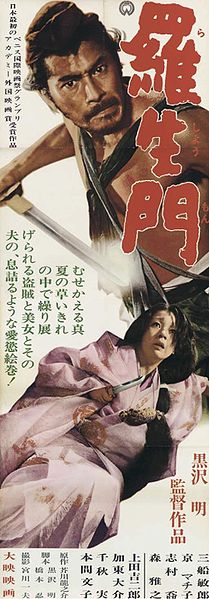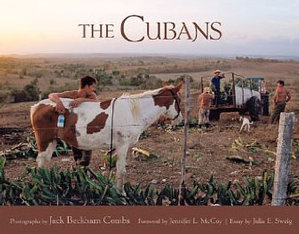LETTERS FROM THE GLOBAL PROVINCE
Cuba Libre: Global Province Letter June 16, 2010
I have, let's see,
that I have learned to read,
to count,
I have that I have learned to write,
and to think,
and to laugh.
I have… that now I have
a place to work
and earn
what I have to eat.
I have, let's see,
I have what I had to have.
---- Nicolás Guillén, “Tengo.”
 Rashomon. Japanese cinema marched onto the world’s stage in 1950 with the appearance of Rashomon. Directed by the amazing Akira Kurosawa, and starring the compelling Toshirö Mifune, it was a crime mystery without solution. The rape of a woman and the murder of her samurai husband are recounted in flashbacks from four witnesses. The final telling, from the woodcutter, is taken to be the truth, but we feel it, too, is tainted, since it also is marred by time and subverted by the character flaws of the witness. Even the trailer makes clear to us that darkness and lies color every scene.
Rashomon. Japanese cinema marched onto the world’s stage in 1950 with the appearance of Rashomon. Directed by the amazing Akira Kurosawa, and starring the compelling Toshirö Mifune, it was a crime mystery without solution. The rape of a woman and the murder of her samurai husband are recounted in flashbacks from four witnesses. The final telling, from the woodcutter, is taken to be the truth, but we feel it, too, is tainted, since it also is marred by time and subverted by the character flaws of the witness. Even the trailer makes clear to us that darkness and lies color every scene.
Cubra Libre. Truth is equally elusive in another island nation. Cubra Libre has a host of meanings. For us it conjures up a drink we have every few years, and, at other times, it is a cigar with a fine decorative wrapper that should not be smoked too often. As well, it’s the title of a bunch of songs in various countries, and graces the cover of many novels, including one by the gothic Elmore Leonard. The term has many origins, depending on who is telling the story. It and Cuba are just other re-incarnations of the unsolvable Rashomon. 
Time and human character have so muddled the story of Cuba that we can be pretty sure nobody has got it right. One version of the Cubra Libre song presents a confused image of Castro’s Cuba. We must accept the fact that all the interpretations drawn for us of Cuba are no more than small, incomplete fragments of a much larger mosaic.
For sure the very words “Cuba Libre” are a comedic oxymoron. The Cubans have never been free, even after they were cut loose from the Spanish. They’re always wearing a yoke, either a rope fashioned by foreigners or a noose of their own making. “Free” has not been their lot. Prior to Castro we may have pictured it as a paradise of fun and freedom for Americans, but it was also a retreat for Meyer Lansky and the American mob, and an escape for Ivy League debutantes who, after unfortunate romances, went there to lick their wounds and put the knife to their lurking problems.
Just as Castro took up power and before embargoes and other barriers came into play, a carousing university student, not too serious about his graduate work, might fly off to a Cuba in the spring. Cuba was desperate for tourist dollars. Free daiquiris were dished out at the airport, and this carefree traveler drank so many that he missed the free bus into Havana. So he had to pay up for a cab. Naturally he left more money behind than he should at the various clubs and hotels he visited. This excursion, of course, was just a prelude to what followed: he soon ran off to Tahiti and Hawaii.
Fidel. The accounts of this isle since Castro became a banana czar are colored, too, by preconceptions, ideology, and lack of historic perspective. In “Cuba Libre?” and “Looking for History and Better Bread,” we provide snapshots that are no more than that. Americans and Europeans, we would suggest, have a disconnect with Latin America and the Caribbean, which insulates the West from Cuba’s essence. The profound analyses that come out of our think tanks and semi-scholarly journals are deeply lightweight, no matter the packaging. And the regime there is so caught up in the rhetoric of sugared socialism that it, too, does not see its own Cuba very well. When the web of government is too thick, nobody but nobody sees things very clearly.
 Jumping Backwards. Probably one has to jump back a few decades to get a look at the Cuban soul. Take a look, for instance, at Wilfredo Lam, the Cuban Picasso. Of Chinese, and Congolese, and mulatto ancestry, he tells us of all the human strains that feed into the Cuban experience. He “sought to portray and revive the enduring Afro-Cuban spirit and culture. Inspired by and in contact with some of the most renowned artists of the twentieth century, Lam melded his influences and created a unique style, which was ultimately characterized by the prominence of hybrid figures.” He wedded Africa and the West, the primitive with steely modern, raw nature and urbanity, animistic Santeria religion and modern theory. Neither poverty nor isolation nor a Stalinist state have abolished the DNA he portrayed.
Jumping Backwards. Probably one has to jump back a few decades to get a look at the Cuban soul. Take a look, for instance, at Wilfredo Lam, the Cuban Picasso. Of Chinese, and Congolese, and mulatto ancestry, he tells us of all the human strains that feed into the Cuban experience. He “sought to portray and revive the enduring Afro-Cuban spirit and culture. Inspired by and in contact with some of the most renowned artists of the twentieth century, Lam melded his influences and created a unique style, which was ultimately characterized by the prominence of hybrid figures.” He wedded Africa and the West, the primitive with steely modern, raw nature and urbanity, animistic Santeria religion and modern theory. Neither poverty nor isolation nor a Stalinist state have abolished the DNA he portrayed.
As well, one should look to Cuba’s great hero Jose Marti, a goad for the country’s independence in the 19th century. “In his short life he was a poet, an essayist, a journalist, a revolutionary philosopher, a translator, a professor, a publisher, and a political theorist.”
“After his death, one of his poems from the book, "Versos Sencillos" (Simple Verses) was adapted to the song, "Guantanamera," which has become the definitive patriotic song of Cuba.” Significantly we think he was able to combine political aspiration with a love for literature: his quest for Latin American liberty did not dim his appreciation of literature and beauty. He stood for a Cuba with more dimensions than that articulated by those who today banally picture it in writing or photographs.
Marti’s poetry even captures the balance he achieves between beauty and political statement. Such is “Cultivo Una Rosa Blanca”:
I cultivate a white rose
In July as in January
For the sincere friend
Who gives me his hand frankly
And for the cruel person who tears
out the heart with which I live,
I cultivate neither nettles not thorns:
I cultivate a white rose
Growing a society, in his eyes, is like growing a beautiful white rose.
 The Cubans.The Cuba that was at the beginning of the 20th century brings us to the Cuba that is today. Jack Beckham Combs is just out with a book of his 21st century photographs of Cuba. What we learn on opening its pages is (a) it is mistitled and (b) it is a moving, somewhat sad, but fine photographic journal of Cuba today. As we work our way through its pages, we look at static scenes and a stunned somnolent people. There is a feeling that they may be a bit numb, but certainly we cannot penetrate into their hearts. The spirit is hushed. There’s a slight essay near the beginning entitled “Cuba in Limbo,” and those very words could well have become the title for the whole book, for that’s what we’re seeing in this work. There’s a time warp: we find ourselves waiting for Cuba to wake up. Indeed, the animals often look more energized than the people. We particularly recommend the yoke of oxen on page 64.
The Cubans.The Cuba that was at the beginning of the 20th century brings us to the Cuba that is today. Jack Beckham Combs is just out with a book of his 21st century photographs of Cuba. What we learn on opening its pages is (a) it is mistitled and (b) it is a moving, somewhat sad, but fine photographic journal of Cuba today. As we work our way through its pages, we look at static scenes and a stunned somnolent people. There is a feeling that they may be a bit numb, but certainly we cannot penetrate into their hearts. The spirit is hushed. There’s a slight essay near the beginning entitled “Cuba in Limbo,” and those very words could well have become the title for the whole book, for that’s what we’re seeing in this work. There’s a time warp: we find ourselves waiting for Cuba to wake up. Indeed, the animals often look more energized than the people. We particularly recommend the yoke of oxen on page 64.
St. Clair Newbern, a friend of Combs who has contributed several photographs to the Global Province, writes of their first meeting:
I first met Jack in a telephone conversation in early 2001. We had both
signed up for a week long trip to Cuba with David Alan Harvey, one of
the world's best documentary photographers (National Geographic -
Magnum Photos), but we had both decided at the last second against
making the trip to Cuba when the workshop sponsors
were unable to answer some very simple questions, like where are we
going to be staying, and will the instructor actually be there?
But, of course, both of them, lawyers by trade, have since managed to get past all the complications and visit Cuba many times. As St. Clair remarks about the experience, “When you ask a Cuban about their obviously hard life and how they possibly get by, the answer is always the same... It is not easy.” It is the hardness of the place, along with its resilient beauty, that greets one in The Cubans.
More About Limbo. It is not just that Cuba is in limbo. Our relations with Cuba, and yes with all of Latin America, are in limbo, since we usually think we have bigger fish to fry in Asia and Europe. With the wonderful turnabout of Brazil’s fortunes, fueled by its oil gushers, we are ill served if we put South America and the Caribbean on the back burner. More and more, whether we like it or not, the world is breaking into regional blocs. It is in our interest to better knit together North and South America and to make sure this region has its dazzling day when the 22nd century arrives. The 21st belongs to Asia.
P.S. Talking about Cuba, a wag in the Atlantic opines: "The greatest achievements of Communism are health care, sports, and education. The greatest failures of Communism are breakfast, lunch, and dinner."
P.P.S. We might wonder what has happened to Japanese film, which has been quiescent since Kurosawa passed from the scene. But then, since the 90s, we might wonder what has happened to Japan which seems to have lost its way. While Cuba is an extreme case of rigor mortis, we can point to a raft of nations that seem to have lost their get-up-and-go.
P.P.P.S. For a while Octavio went to school in the United States. Off in a prep school in a desolate factory town in Pennsylvania in the late 1950s, he once asked a fellow Roman Catholic, “Do you go to church here?” “Yes,” said his classmate, “But it’s not a cheery experience.” Religion is often a bit too sober in the coal regions of the Keystone State. Octavio responded, “I don’t bother to go here. In Cuba it is so different. You slowly walk down the avenue to church in the sun with a girl friend on your arm. The flowers inside and out are beautiful. The sermon is not punishing. Ah, it is so different.” Isn’t it ironic that today so much pain resides in what should be a happy garden? It reminds one of Hawthorne’s Rappaccini’s Daughter which is populated by beautiful flowers. Alas, they are all poisonous.
P.P.P.P.S. To see a recent more decorative book on Cuba, peek at Violet Isle by Alex and Rebecca Webb. Of course, it is more consciously designed, and the production and the photos are cleverly orchestrated. Composition dominates the subject matter.
P.P.P.P.P.S. Even today art is more revealing than all the documentaries about Cuba and its diaspora. For instance, Carlos Eire’s Waiting for Snow in Havana: Confessions of a Cuban Boy looks into Cuba and the exile’s world. “The world changed while I slept, and much to my surprise, no one had consulted me.”
P.P.P.P.P.P.S. Castro, in his dotage, long after the Russians have withdrawn their massive financial support for his regime, still retains his ardor for his imagined Soviet friends. If we are to believe Christopher Hitchens, Fidel has called for the building of a Russian Orthodox Cathedral in Havana. He even seems touched by religion, as revealed in his writings: “This church, wrote Castro, [i]s a spiritual force. It played a major role at critical times in the history of Russia.” More than anything, this odd behavior seems to suggest just how superannuated the Castros are. Fidel is 84 and Raul is 79: no wonder the country is locked in reverse. It is as if time is standing still, so that these two artifacts can enjoy the myths that engulf them.
P.P.P.P.P.P.P.S. Sugar prices are occasionally doing pretty well these days. The sugar republic of Cuba could even enjoy a little bit of prosperity if it straightened out its politics and its agricultural practices.
P.P.P.P.P.P.P.P.S. Cuba is just one unhappy legacy from the Spanish-American War. In the Pacific, Dewey did the Philippines, another nation that has never quite come together.
Home - About This Site - Contact Us
Copyright 2010 GlobalProvince.com